#German Expressionist Prints
Text

Otto Mueller
Zwei Mädchen Und Stehender Jüngling
1910
#otto mueller#die brücke#german art#german artist#german expressionism#german painter#german painting#german expressionist#expressionist#expressionist painting#expressionist art#expressionism#art on tumblr#print making#print#modern art#art history#aesthetictumblr#tumblraesthetic#tumblrpic#tumblrpictures#tumblr art#aesthetic#beauty
10 notes
·
View notes
Photo
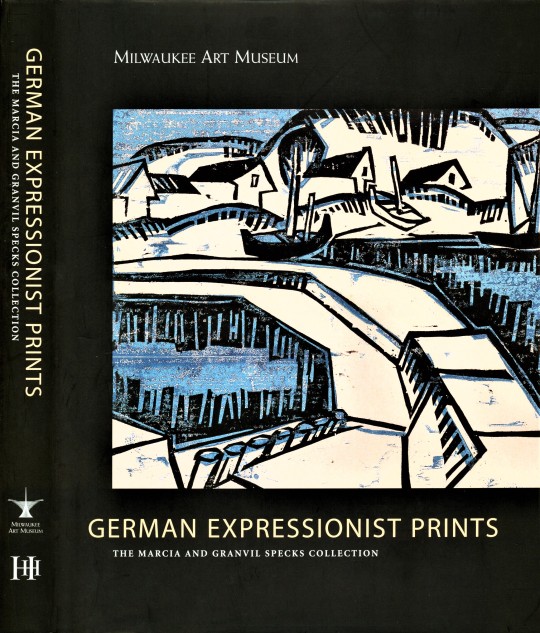


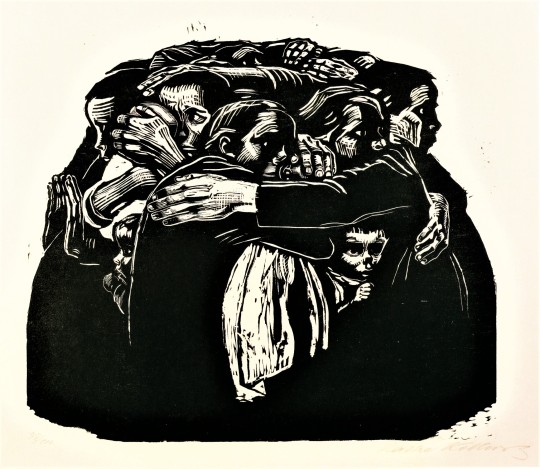
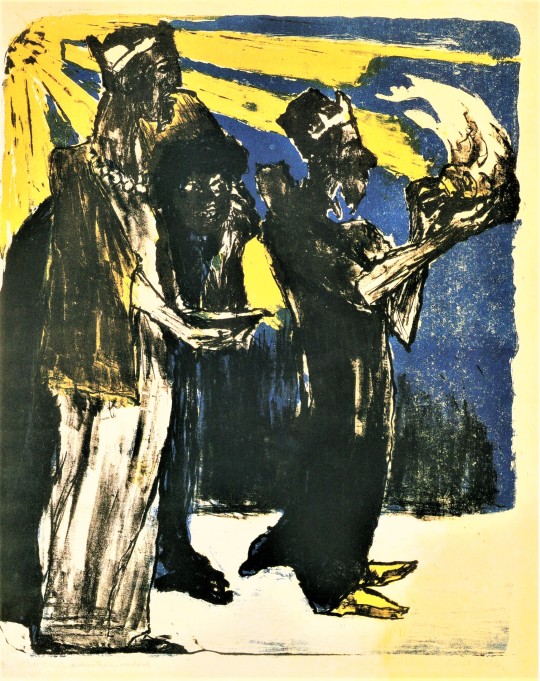

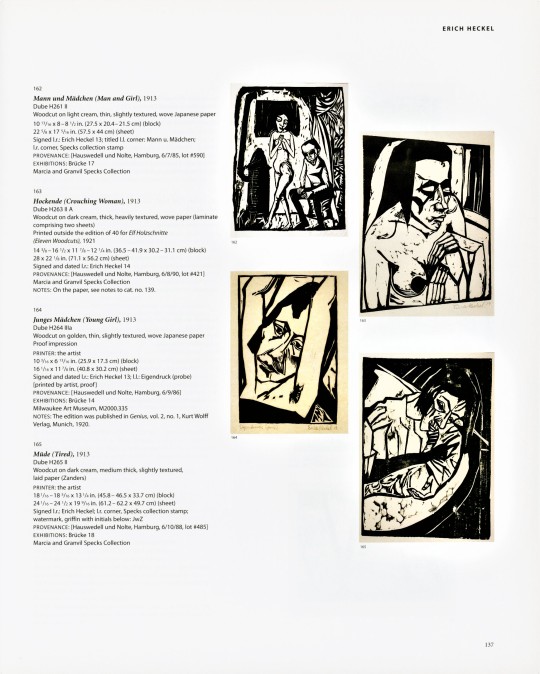



Staff Pick of the Week
This week I am sharing German Expressionist Prints: the Marcia and Granvil Specks Collection: Milwaukee Art Museum, published by Milwaukee Art Museum, Milwaukee, WI, and Hudson Hills Press, Inc., Manchester Vermont, 2003. This book was published to accompany a traveling exhibition of a selection of prints from the Specks Collection, which was on view at the Milwaukee Art Museum in 2004.
This collection, which lives at the Milwaukee Art Museum is one of the most significant collections of German Expressionist prints in the United States. This book features over 500 color reproductions of the works as well as essays, a catalogue of the prints, and artist bios.
For artists and art students like myself, catalogues such as this one are incredible resources for broadening our visual vocabulary and offering inspiration and broader understanding of our place in art history. The artworks in these kinds of books may be thousands of miles away, stored in back rooms of museums or in private collections. Many of the works in books such as this one are not even accessible online.
These books may be costly to acquire but many libraries, like UWM’s, have large collections of books like these that are free for you to check out and peruse.
Lucky for us the more than 450 prints in the Marcia and Granvil Specks Collection have their own gallery in the Milwaukee Art Museum where they are on continuous rotation. You and I are also able to see these works at the Herzfeld Photography, Print, and Drawing Study Center by appointment!
Use this link for more Staff Pick of the Week posts!
Teddy, Special Collections Graduate Intern
#staff pick of the week#milwaukee art museum#German Expressionist Prints#German Expressionism#Marcia and Granvil Specks Collection#Milwaukee#Printmaking#Art History#Art Museums#German Art#Art Collections#art books#hudson hills press#Art Exhibition#Woodcuts#teddy#etching#prints#lithographs
38 notes
·
View notes
Text

chestnut tree in the moonlight (kastanienbaum im mondlicht) by ernst ludwig kirchner, 1904, woodcut print
14 notes
·
View notes
Text
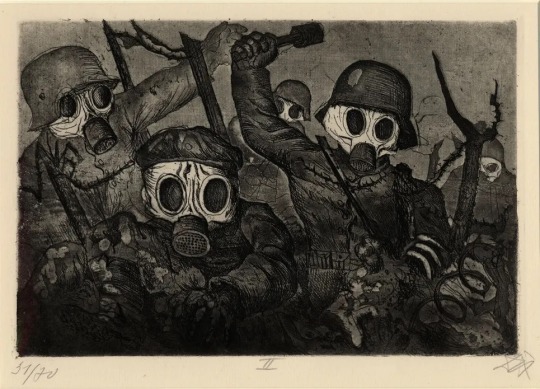
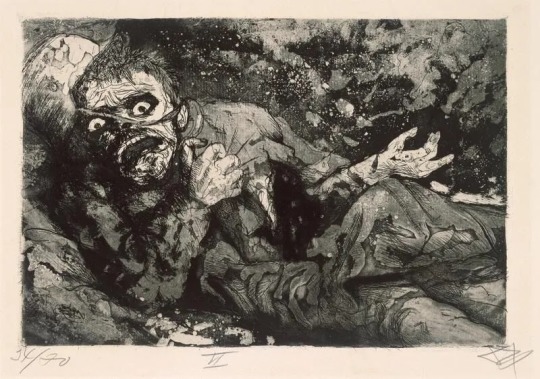
two prints from ‘the war’ series (1924) - otto dix
otto dix served in the war of 1914-18 as an artillery gunner in the trenches. the german expressionist recreated the images that he saw in his nightmares in this series of prints, titled ‘the war’. for dix, prints like this were an exorcism of the horrors he saw.
#art#art history#curators#culture#museums#history#war#expressionism#german expressionism#german art#world war one
628 notes
·
View notes
Text
Rewind the Tape —Episode 1
Art of the episode
During our rewatch, we took note of the art shown and mentioned in the pilot, and we wanted to share. Did we miss any? Do you have any thoughts about how these references could be interpreted? How do you think Armand and Louis go about picking the art for their penthouse in Dubai?

The Fall of the Rebel Angels
Peter Bruegel the Elder, 1562
This painting is featured in the Interview with the Vampire book, and it was important enough to be included in the draft pilot script!

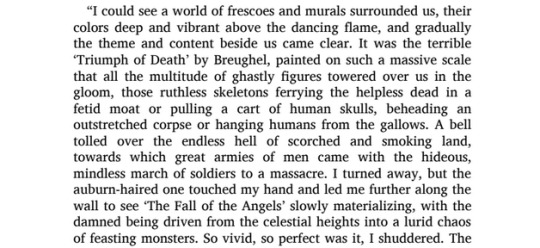
Bruegel the Elder was among the most significant Dutch and Flemish Renaissance artists. He was a painter and print-maker, known for his landscapes and peasant scenes.

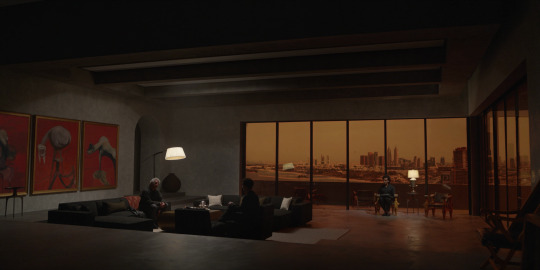

Three Studies for Figures at the Base of a Crucifixion
Francis Bacon, 1944
Bacon was an Irish figurative painter, known for his raw, unsettling imagery and a number of triptychs and diptychs among his work. At a time when being gay was a criminal offense, Bacon was open about his sexuality, and was cast out by his family at 16 for this reason. He destroyed many of his early works, but about 590 still survive.
The Tate, where these paintings are displayed, says this about the work: "Francis Bacon titled this work after the figures often featured in Christian paintings witnessing the death of Jesus. But he said the creatures represented the avenging Furies from Greek mythology. The Furies punish those who go against the natural order. In Aeschylus’s tragedy The Eumenides, for example, they pursue a man who has murdered his mother. Bacon first exhibited this painting in April 1945, towards the end of the Second World War. For some, it reflects the horror of the war and the Holocaust in a world lacking guiding principles."


Strawberries and Cream
Raphaelle Peale, 1816
Peale is considered to have been the first professional American painter of still-life. [Identified by @diasdelfuego.]

Outfits inspired by J.C. Leyendecker
Leyendecker was one of the most prominent and commercially successful freelance artists in the U.S. He studied in France, and was a pioneer of the Art Deco illustration.
Leyendecker's model, Charles Beach, was also his lover of five decades. You can read costume designer Carol Cutshall's thoughts on these outfits on her Instagram.
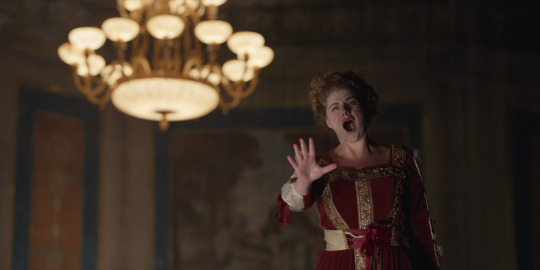
Iolanta
Pyotr Tchaikovsky, 1892
The opera Louis and Lestat go to was composed by Tchaikovsky, another gay artist. The play tells a story "in which love prevails, light shines for all, lies are no longer necessary and no one must fear punishment," as put by Susanne Stähr for the Berliner Philharmoniker.

On the Hunt or Captain Percy Williams On A Favorite Irish Hunter
Samuel Sidney, 1881
The unidentified painting on the right might be from the same hunting series, though we couldn't identify the exact one. There's also a taxidermy deer, ram, and piebald deer on the wall. [Identified by @vfevermillion.]

The Artist's Sister, Melanie
Egon Schiele, 1908
Schiele was an Austrian expressionist painter and protege of Gustav Klimt. Many of his portraits (self portraits and of others) were described as grotesque and disturbing. [Identified by @dwreader.]
A Stag at Sharkey's
George Wesley Bellows, 1909
Bellows was an American realist painter, known for his bold depictions of urban life in New York City. [Identified by @vfevermillion.]

Mildred-O Hat
Robert Henri, undated (likely 1890s)
Henri was an American painter who studied in Paris, where he learned from the Impressionists and determined to lead an even more dramatic revolt against American academic art. [Identified by @nicodelenfent, here.]
Starry night
Edvard Munch, 1893
Munch was a Norwegian painter, one of the best known figures of late 19th-century Symbolism and a great influence in German Expressionism in the early 20th century. His work dealt with psychological themes, and he personally struggled with mental illness. [Identified by @vfevermillion.]
If you spot or put a name to any other references, let us know if you'd like us to add them with credit to the post!
Starting tonight, we will be rewatching and discussing Episode 2, ...After the Phantoms of Your Former Self. We hope to see you there!
And, if you're just getting caught up, learn all about our group rewatch here ►
#louis de pointe du lac#daniel molloy#lestat de lioncourt#vampterview#interview with the vampire#iwtv#amc interview with the vampire#interview with the vampire amc#amc iwtv#iwtv amc#IWTVfanevents#rewind the tape#in throes of increasing wonder#analysis and meta#art of the episode
65 notes
·
View notes
Text
The Future Is Noir
Scenography for the darkness with the uncertain future. Architecture of fear in the cinema of 1920s.

Considered the quintessential work of German expressionist cinema, the Cabinet of Dr. Caligari (1920) by Robert Wiene tells the story of an insane hypnotist who uses a brainwashed somnambulist to commit murders.
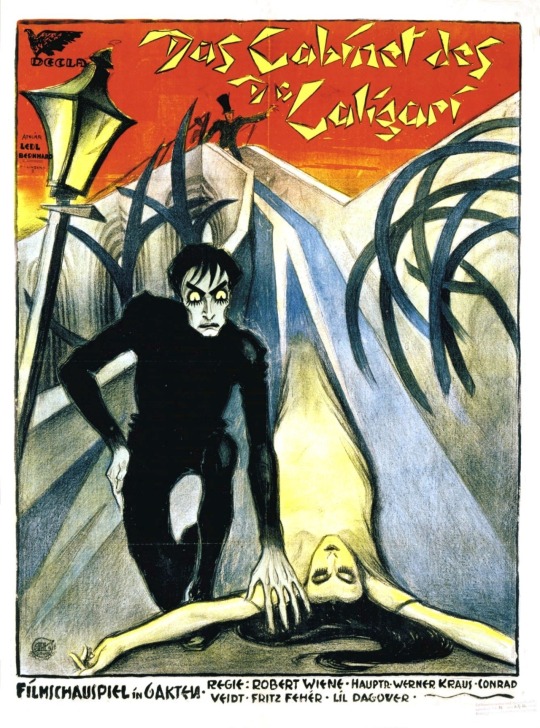
youtube
The film thematizes brutal and irrational authority. Caligari can be representing the German war government, with the symbolic of the common man conditioned to kill. The film include the destabilized contrast between the subjective perception of reality, and the duality of human nature.

An unofficial adaptation of Bram Stoker's 1897 novel Dracula in film is the German version of Nosferatu: A Symphony of Horror (1922) by F. W. Murnau. Nosferatu is an archaic Romanian word Nesuferitu` meaning the offensive or the insufferable one. The movie is actually about the First World War and the plague is a metaphor for the mass death and destruction of the war.

youtube
Nosferatu was banned in Sweden due to excessive horror until 1972. All known prints and negatives were destroyed under the terms of settlement of a lawsuit by Bram Stoker's widow.

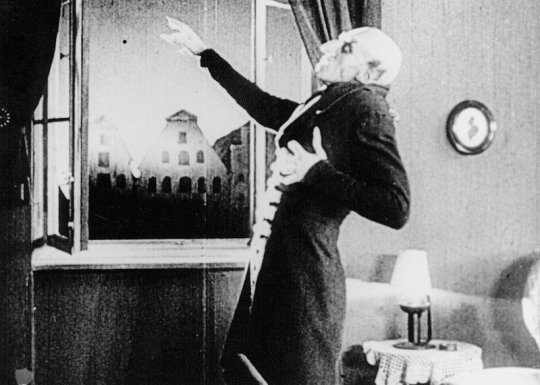
Berlin – Die Sinfonie der Großstadt (1927) is an experimental documentary by Walther Ruttmann. It begins with a drive of a high-speed train pulled by a steam locomotive through meadows, arbor and residential areas into the city and thus delimits the surrounding area from the big city.

The train arrives at Anhalter Bahnhof near the city center, where streets empty in the morning are filling up with people on their way to work. The rhythm of the city is getting faster and faster. With the 12 o'clock bell strike, the speed collapses. After lunch break and food intake, however, it begins to accelerate again in the afternoon.
youtube

Cabiria (1914), an Italian epic silent film by Giovanni Pastrone, was shot in Turin. The film is set in ancient Sicily, Carthage, and Cirta during the period of the Second Punic War (218–202 BC).

It follows a melodramatic main plot about an abducted little girl, Cabiria, and features an eruption of Mount Etna, heinous religious rituals in Carthage, the alpine trek of Hannibal, Archimedes' defeat of the Roman fleet at the Siege of Syracuse and Scipio maneuvering in North Africa.
youtube

One the most influential films in cinema history, Dziga Vertov's exhilarating ode to Bolshevik Russia the Man with a Movie Camera (1929). It is a visual argument for the place of the documentary filmmaker as a worker, educator, and eyewitness in a proletariat society. The film is an impressionistic view of urban daily life, seen from a purely cinematic perspective.

youtube


74 notes
·
View notes
Text
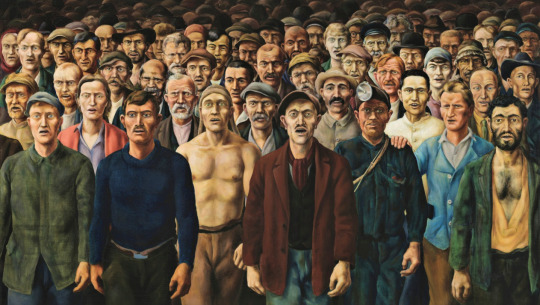
Otto Griebel - "The Internationale" - circa 1929.

Otto Griebel - "Factory Workers on Their Way Home" - circa 1922.
Watercolor over pencil on smooth wove paper. Hard Times: Germany 1920s – 1930s - Series
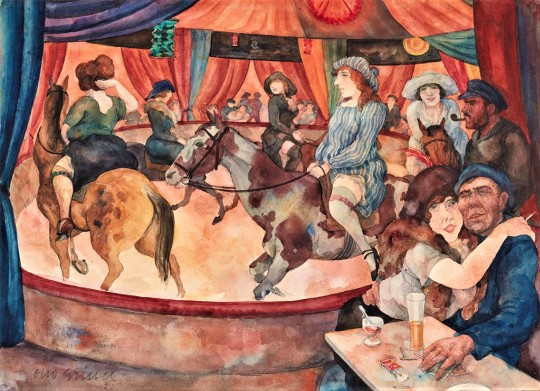
Otto Griebel - "Hippodrome in St. Pauli" - circa 1923.
Otto Griebel was a German artist who was born in 1895. He was the co-founder of the Association of Revolutionary Visual Artists of Germany & the New Dresden Secession.

Otto Griebel - Self Portrait
In 1920, he founded together with the musician Otto Kunze a puppet theatre (glove puppets) in Dresden. Its repertoire included a puppet cabaret, an adaptation of Faust and of Richard Wagner’s Lohengrin entitled Der Lohntütengrien. Besides political satire, he cultivated “nonsense”, for which, as a former Dadaist, he had an affinity. The verses of his friend, Joachim Ringelnatz provided material for this part of the program.
In 1933, he was arrested by the Gestapo and his paintings were branded as degenerate art.
His painting (below) "Child at a Table" branded as degenerate art, was one of the artworks found in the 2012 Munich artworks discovery (Munich Art Hoard).

Degenerate Art also was the title of a 1937 exhibition held by the Nazis in Munich, consisting of 650 modernist artworks that the Nazis had taken from museums, that were poorly hung alongside graffiti and text labels mocking the art and the artists.

Joseph Goebbels views the Degenerate Art Exhibition.
The collection of "Degenerate Art" contained Old Masters as well as Impressionist, Cubist, and Expressionist paintings, drawings and prints by artists including Claude Monet, Pierre-Auguste Renoir, Paul Cézanne, Paul Gauguin, Henri Matisse, Eugène Delacroix, Edgar Degas, Henri de Toulouse-Lautrec, Franz Marc, Marc Chagall, Édouard Manet, Camille Pissarro, Auguste Rodin, Otto Dix, Edvard Munch, Gustave Courbet, Max Liebermann, Wassily Kandinsky, and Paul Klee, among many others.
#art#paintings#mixed media#Munich Art Hoard#degenerate art#facism#Otto Griebel#watercolor#Child at a Table#portraits#Hippodrome in St. Pauli#Factory Workers on Their Way Home#the internationale
59 notes
·
View notes
Text
by Ben Cohen
One of Canada’s leading French-language news outlets abruptly removed a crudely antisemitic caricature of Israeli Prime Minister Benjamin Netanyahu from its website on Wednesday morning following a storm of protest from Canadian politicians and Jewish advocates.
The image, drawn by veteran cartoonist Serge Chapleau — who has won several awards for his work and was honored with the Order of Canada medal in 2015 — was published by the Montreal-based newspaper La Presse and appeared on the front page of its print edition. It showed Netanyahu as Nosferatu, the titular character of a classic 1922 German Expressionist silent movie about a blood-sucking vampire, Count Orlok, who preys upon a real estate agent and his wife under the cover of purchasing a house and who, later in the film, unleashes a plague of rats onboard a ship on which he is traveling. The film is based on the famous 1897 novel Dracula, set in Romania.
Chapleau’s cartoon imposed Netanyahu’s features on that of a vampire wearing a grim, lifeless expression, with his hands replaced by long claws. An accompanying text displayed the word “Nosfenyahou” — a contraction of “Nosferatu” and the Francophone spelling of Netanyahu’s last name — dripping with blood. Another text beneath declared “On the way to Rafah,” the city in Gaza where Israeli troops have been battling Hamas terrorists.
Historically, antisemitic caricatures of Jews frequently depicted them as blood-suckers, building on earlier Christian libels that falsely accused Jews of using the blood of Christians in their religious rituals. Since the Oct. 7 Hamas pogrom in Israel, the same motif has appeared across the Arab world in relation to Israel’s war against Hamas in Gaza, with news outlets in Morocco, Jordan, and Qatar all publishing cartoons of Netanyahu drinking the blood and consuming the flesh of Israel’s adversaries.
By the middle of Wednesday morning, La Presse had removed its contribution to the genre following widespread protests on social media. However, the paper has not apologized for the offending image nor offered an explanation as to why it was published to the 860,000 followers of its feed on X/Twitter.
“No big deal, just the second-largest newspaper in French Canada caricaturing Jews as vampires,” David Frum — a Canadian-American writer and former speechwriter for US President George W. Bush — remarked in a post. Frum added: “That’s how antisemitism often works. A rich inventory of anti-Jewish images and themes pre-exists: the Jew as bloodsucker, the Jew as child-killer, the Jew as alien enemy. When a user wants to vent rage or dislike … the resource accumulated over centuries is waiting for him.”
Canadian politicians who condemned the cartoon included Quebec Senator Leo Housakos, who said he had been “appalled” by it.
“While Mr. Netanyahu, as with any politician, is not above criticism, this kind of antisemitic trope is reminiscent of the 1930s. I’m saddened for Jews across Canada for the level of hate to which we, as Canadians, have co-signed,” Housakos’ X/Twitter post continued.
17 notes
·
View notes
Note
Hiii! This question is kinda apropos of nothing but I’m curious: who is the person in your profile pic? Every time I scroll past it a little too fast I think it’s Alan Alda/Hawkeye haha
no worries (i think alan alda would be honoured, if i remember correctly, he mentioned meeting him once as a kid in his memoir). it's this fellow:


his name was conrad veidt, a famous german actor of the weimar republic, later escaped to britain and then the us to get away from the nazis with his jewish wife, Ilona Prager. he also starred in two pro-jewish films shortly after the nazis came to power in 1933 (the wandering jew, and jew süss, but i confess i haven't watched these yet, so i cannot say how well they aged) -- generally did a few films that were about Social Issues that came down on the side of the oppressed, including the woman's crusade, and the merry-go-round, as well as... (see below)
famous for some very important movies:
1. played the lead in the first movie to openly portray gay men (anders als die andern), which was produced by magnus hirschfeld and the institute of sexology in a bid to get support for legalising homosexuality -- it's free on youtube! also 105 years old, can you believe...
2. played the somnambulist in the cabinet of dr caligari, and generally was every vamp-girls/boys dream back in the day, playing in a lot of the german expressionist films and proto-horror films, and generally not afraid to play offbeat, uncomfortable roles that weren't about being an attractive leading man (eerie tales, the hands of orlac, waxworks, the man who laughs)
3. after he moved to the us, he was very happy to portray nazis to give them realism, and he plays major heinrich strasser in casablanca in 1942 (his second-last film)
i believe he was in a total of 115 films, but quite a few of them between when he started in 1917 and 1930 are lost (der januskopf, i think of you often....murnau, bela lugosi, and conrad veidt, in an adaptation of jekyll and hyde??? arghhh)
other fun facts, did occasionally crossdress and in fact this may have contributed a little to his first divorce, as his wife found him and a bunch of his friends wearing dresses one night after she came back from work -- notably conrad was in her new dress. she told a friend that this was the breaking point, but it may have partially been a joke. they did divorce though
was also at one point called the prettiest girl in berlin in print, good for him
was probably bisexual, although having said that i've actually never read why people think this -- so for now, he was a mensch and a great ally to a lot of people, a little on the queerer side in all things
i do follow a fair few conrad veidt blogs on here, but i don't talk about him often, it's one of those "am a fan, but keeping it mostly to the chest" kind of things with him -- however, as you can tell, very happy to give the Info when asked!
that's the man, the girl, the pretty boy: mr conrad veidt!
#conrad veidt#really i ought to get a book on him to fill in the gaps in my knowledge#a lot of the time im happy to just chill with what i know and different articles but.. i like a good book#weimar republic#weimar berlin#anders als die andern#queer history#queer cinema#cabinet of dr caligari#casablanca
14 notes
·
View notes
Text
Sonic the Hedgehog games were a big influence on my aesthetic during my formative years so even if I don't play them I enjoy seeing the new stuff, but the zones in Superstars especially feel kind of generic. Oh there's some green hills and a desert and a ruined underwater city and a robot city? Cmon man. Has the series just been running so long they've used up all the options? So I brainstormed some weirder ones, Sega please steal these
Hydroponic Hotworks Zone: a hydroponic chili pepper farm and hot sauce factory
Charbroil Chophouse Zone: who doesn't want to see Sonic and friends racing and fighting robots in a giant steakhouse
Iron Umlaut Zone: classic heavy metal visuals: skeletons, tanks, Vikings, dragons, pyrotechnics, guitars, and leopard-print
Disco Drainpipe Zone: a sewage treatment plant that has been turned into an underground dance club
Populuxe Night Zone: inspired by googie architecture and mid-century space-age futurism
Ordinary Officepark Zone: a thrilling world of fabric cubicle panels where all of Eggman Industries' paperwork is filed
Penrose Powerhouse Zone: a power plant containing miniature black holes, featuring all kinds of messed up gravity
Spookatronic Sweetworks Zone: a high-tech Halloween candy factory
Chilldown Chapel Zone: a cryostasis facility where historical figures are preserved in ice. Or is that too morbid
I can't think of a clever name but I'd love to see a German Expressionist zone
7 notes
·
View notes
Photo

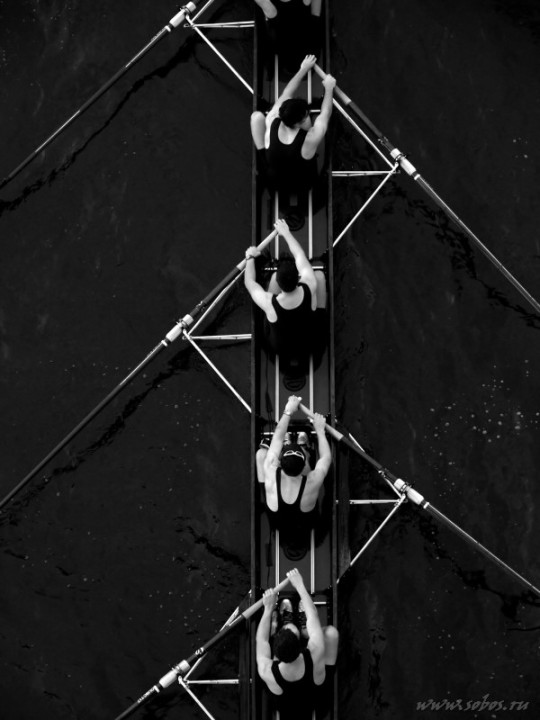
1 Cyril Power (1872-1951) UK The Eight reduction lino cut print (1930) 32.3×23.4cm
2 photographer unknown
economist.com
IT HAS become the custom nowadays,” wrote Claude Flight, a British artist, in 1926, “to go to a shop for the tools of one's trade.” Flight was scornful of shoppers and liked to make things for himself. He kept his own bees and championed the art of the linocut, believing that the use of cheap materials would help democratise art and bring it to the attention of the masses. For his own linocuts he insisted on “a sharp penknife—such a very rare thing among art students” and a gouge he fashioned by fitting a small wooden handle onto a rib he cut from an umbrella.
Hard to imagine health and safety regulations allowing children today to have such fun. But Flight, who was a friend to Henry Moore, Ben Nicholson and Barbara Hepworth, inspired many pupils at the Grosvenor School of Modern Art, where he taught, wrote and organised exhibitions on linocuts.
Among the most famous was Cyril Power, an extraordinarily creative printmaker, born in 1872, who soaked up Flight's enthusiasms and gave them new force. Power drew on many influences—of the German Expressionists (who invented linocutting before the first world war), the Italian Futurists, the Vorticist prints and paintings of Wyndham Lewis—and the enthusiasm for speed and movement that marked the work of so many artists of the period, from Natalya Goncharova to Marcel Duchamp.
While the work of the Germans, Italians, French and Russians has become very well known, the prints and linocuts made by Power and his fellow British artists have lingered in the shadows. An inspired little exhibition—the first major show of Modernist British prints in America, which began earlier this year at the Museum of Fine Arts in Boston and is now at the Metropolitan Museum in New York—will help change that. So too will a newly opened show at a private gallery in London that gathers together for the first time prints of all 46 of Power's linocuts. Some are for sale; others have been lent by museums and private collectors, of which the most important are two New Yorkers, Leslie and Johanna Garfield.
The first impression of the Power show is that he lived his life in reverse. Until he was almost 50 he followed in the professional footsteps of both his father and his grandfather and practised as an architect, making a name for himself also as the author of an erudite study entitled “English Medieval Architecture”. Then, as Philip Vann explains in an elegant essay that accompanies the show, he “embarked on a kind of Gauguin-esque adventure”, leaving his wife and four children to enrol in art school in the company of a 24-year-old artist, Sybil Andrews.
The early prints in the show were made by a middle-aged man and it shows. In black-and-white there is a bridge at Rickmansworth, a street corner in the sleepy Suffolk town of Lavenham. Then suddenly the movement of the windmill in “Elmers Mill, Woolpit” gives an indication of what is to come. Starting in 1930, when he was already 58, Power takes to speed as if he had taken personal charge of the Futurist manifesto, which C.R.W. Nevinson co-signed with an incendiary Italian, Filippo Marinetti, in 1914, with the words “Forward! HURRAH for motors! HURRAH for speed!…HURRAH for lightning!”
Power allows light, noise and speed into everything he sees. Using a series of easily recognised colours, particularly “Chinese orange”, “chrome orange”, “viridian” and “Chinese blue”, he created images of merry-go-rounds, rowers, acrobats, dancers, runners, hockey players and, of course—given that some of his influences were Italian—beautiful cars.
The most successful are those, like “The Eight”, in which the element of formal design is most visible. But Power's vision as an artist really comes to the fore in works containing a hint of menace. The bourgeois-assaulting spirit of Italian Futurism, Mr Vann explains, had fallen into the malign hands of Mussolini and was about to give way to Fascism, while Freud's and Jung's obsessions with the unconscious were increasingly helping to throw up visions of fears, hopes and dreams.
“Monsignor St Thomas” (1931, pictured at left) is a brilliant working of the murder in the cathedral of Thomas à Beckett, but it is technically skilful rather than edgy. The really potent, and most modern-looking, of Power's linocuts are those that lead the viewer right to the edge. These start with “Tennis” (1933, below), a magnificent rendering not just of the energy of the centre court, but of the physical and psychological effects of slicing and spinning—sport at its most gladiatorial.
As the 1930s move towards totalitarianism and then war, Power's work takes on a darker hue. The tube trains and the escalators of the London subway system provide ample opportunity for exploring man's addiction to the rat race. Two further works seem remarkably prescient. In 1934 Power made a linocut which he called “Exam Room”, full of hunched-up concentration and a complex set of figures that show, in turn, fear, nerves, gloating, dreaming—and one who is slyly distracting a neighbour. Watching over them is the overbearing timekeeper and the all-seeing eyes in the ceiling.
Similarly, “Air Raid”, which Power made in 1935 and which has been lent to this show by the RAF Museum in Hendon, is an extraordinarily filmic response to a period of history the artist had not yet even seen. It would be another five years before the start of the Battle of Britain would make such imagery routine. Cyril Power was not just an artist, he was a visionary
3 notes
·
View notes
Text

Ernst Ludwig Kirchner
Rothaarige Frau - Mie und Gothein
1915
#ernst ludwig kirchner#expressionist#expressionist painting#expressionist art#expressionist painter#expressionist artist#expressionism#german artist#german art#german painter#die brücke#aesthetic#beauty#print#expressionistic#aesthetic beauty#modern art#art history#aesthetictumblr#tumblraesthetic#tumblrpic#tumblrpictures#tumblr art#tumblrstyle#artists on tumblr
4 notes
·
View notes
Text
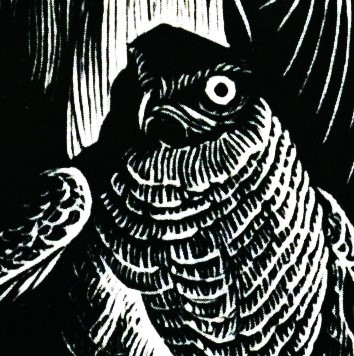


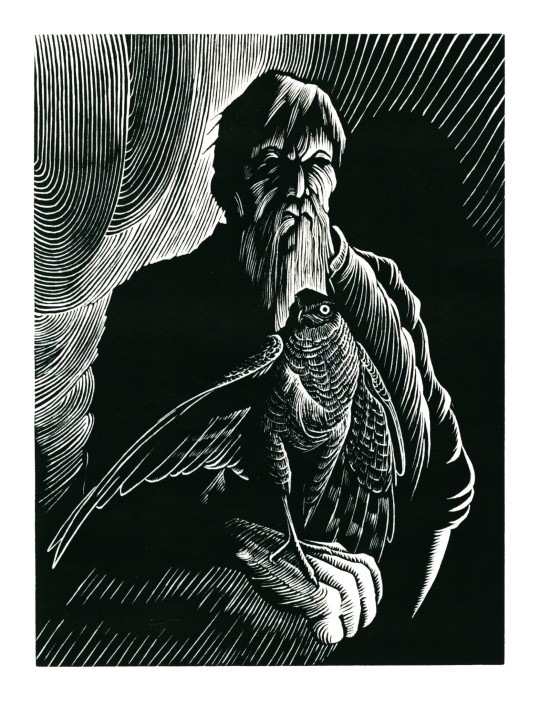
Another Wood-engraved Feathursday
JOHN MCWILLIAMS
Now here's a couple of intense fellows! The print is entitled Sparrow Hawk by South Carolina artist and engraver John McWilliams (b. 1941). The print was selected for inclusion in the Fourth Triennial Exhibition 2020-2022 of the American wood engravers society, the Wood Engravers’ Network (WEN), and this image is from the catalog for that traveling show.
McWilliams's work is inspired by Lowlands flora and fauna, so it seems a little odd that he would choose as his subject the Eurasian Sparrow Hawk (Accipiter nisus) rather than the American Kestrel (Falco sparverius), which is so common to his native habitat. Both species are used in falconry. Nevertheless, both offer something for the engraver, and we enjoy how McWilliams's Sparrow Hawk looks like it's about to take a bow.
John McWilliams received his BFA and MFA from the Rhode Island School of Design and is Professor/Director Emeritus of Georgia State University Ernest G. Welch School of Art and Design. He has received numerous awards, including the Guggenheim Foundation Fellowship and the National Endowment for the Arts Fellowship in photography. Today he maintains a studio in McClellanville, S.C. He counts as his inspirations the work of Albrecht Dürer and the German expressionists, the illustrations of Rockwell Kent, and the graphic novels of Lynd Ward and Frans Masereel. Of working in wood, he writes:
Woodcuts and wood engravings . . . have held much fascination for me. . . . The process of developing an image into a woodcut or wood engraving gives structure to my life. . . . It is such sweet irony that, although the act of creating gives my life structure, it nevertheless produces an enigma, a puzzle that others may interpret through their own lives. There are no easy answers. Such is life.
View more Feathursday posts.
View other posts with engravings from the WEN Fourth Triennial Exhibition.
View more engravings by members of the Wood Engraver’s Network.
View more posts with wood engravings!
#Feathursday#wood engravings#wood engravers#John McWilliams#Eurasian Sparrow Hawk#George Dirolf#Wood Engravers' Network#WEN#WEN Fourth Triennial Exhibition#exhibitions#exhibition catalogs#birds#birbs!
29 notes
·
View notes
Text


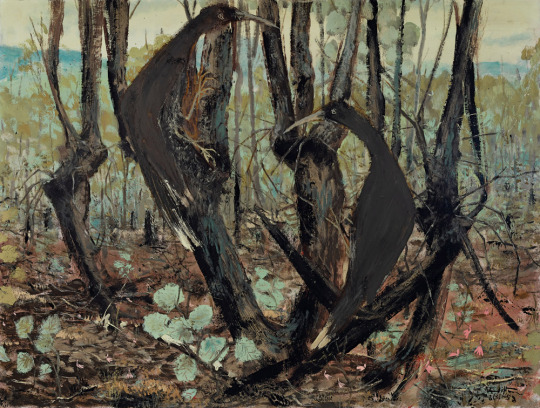

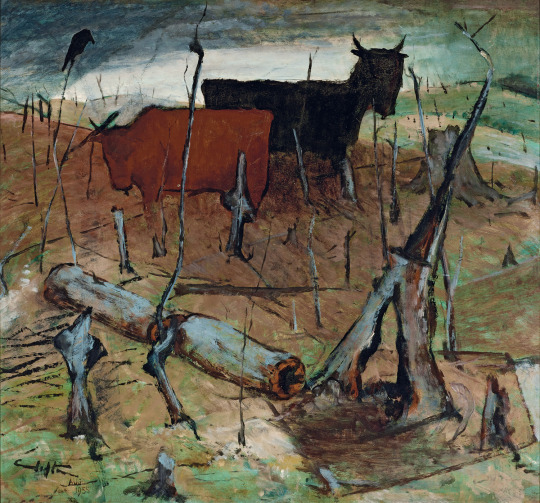
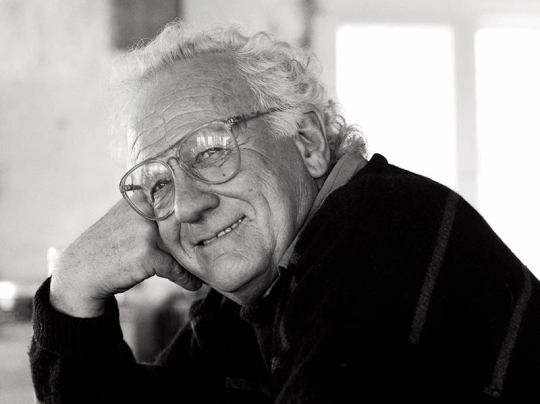


Clifton Pugh (1924 – 1990) was an Australian artist and three-time winner of Australia's Archibald Prize. One of Australia's most renowned and successful painters, Pugh was strongly influenced by German Expressionism, and was known for his landscapes and portraiture. Important early group exhibitions include The Antipodeans, the exhibition for which Bernard Smith drafted a manifesto in support of Australian figurative painting, an exhibition in which Arthur Boyd, David Boyd, John Brack, Robert Dickerson, John Perceval and Charles Blackman showed; a joint exhibition with Barry Humphries, in which the two responded to Dadaism; and Group of Four at the Victorian Artists Society Gallery with Pugh, John Howley, Don Laycock and Lawrence Daws.
Frank Neilson, photographer, tells about his visit to Clifton Pugh:
Clifton Pugh, one of Australia’s most celebrated artists and three-time winner of the Archibald Prize for portraiture, lived on his 15 acre property “Dunmoochin” at Cottle’s Bridge in country Victoria. Clifton, born in Melbourne on 17 December 1924, was a prolific painter and print-maker of landscape and portrait subjects. He received the honour of Officer of the Order of Australia for his services to art. A staunch supporter of the Australian Labor Party, one of his memorable Archibald wins was for his 1972 painting of Labor Prime Minister Gough Whitlam.
"I first saw one of Clifton’s paintings during the early sixties, and was impressed by the very “Australian” style he used. That painting was of the carcase of a dead animal in the desert, painted in strong yellows and reds, with expressionistic black outlining. I got to know Clifton in about 1988, whilst photographing a series of works he had produced on the theme of Leda and the Swan; for which I used a studio lighting technique I had developed which correctly threw the brush-strokes into relief. They were made into high-quality posters, which Clifton loved, saying that they looked as good as the originals." Continue https://frankneilsen.com.au/gallery/clifton-pugh
9 notes
·
View notes
Text

Edmund Kesting- Tanz Dore Hoyer, Dresden, 1926, Silver print unmounted 40 × 29.8 cm.
Dore Hoyer (12 December 1911 – 31 December 1967) was a German expressionist dancer and choreographer. She is credited as "one of the most important solo dancers of the Ausdruckstanz tradition."
2 notes
·
View notes
Text
Possibilities of Print Relief Seminar
Print is part of our day to day lives, its on food labels, the book we read, the clothes we wear, everything has some element of print in it.
Brief History of Print
Etching derived from decorating suits of armour where designs were etched in permanently. The Gutenberg printing press revolutionised the printing of books. It could produce up to 3600 pages per day in comparison to hand printing where up to 40 a day were produced. The Japanese were massive printmakers, using it to showcase fashion and erotic artworks. They mostly used woodblock prints.


Some of the types of printmaking
Relief print
Etching
Lithography
Engraving
Silkscreen
Monoprint
Collograph
Hydro printing
Risoprint
Dry point
Relief Print, (woodcut, linocut)
Involves cutting into a surface, rolling the ink across the top of the surface, wherever you cut into doesn’t receive ink. It’s making a mark and then learning how to transfer this mark. They’re so integral to printmaking as they don’t require elaborate and expensive machinery. Printmaking gives the possibility to create and distribute multiple copies in a short space of time. Take for example the propaganda from Mao Zedongs era of rule. A lot of propaganda from the time was created using relief printing. The physicality and directness of print appeals to many, there’s a lot of force in the image with the strong and unforgiving marks created. Yet there’s simplicity in it.


German Expressionists
They are bold and brash, they focus on the getting the image across while showing the strength of the material and process. They brought a sense of change while being raw and simplistic.

Print in Ireland
Print was never a part of Irish culture so there was no restraint to how artists used print here, there’s no historical confinements, unlike in countries like China and Japan where print plays a huge role in their art history. Artists such as Anthony Davis used blockprinting to portray the struggle at the time of the troubles, his way of expressing himself through print is inspired by the German expressionists.

Paul Catherall
His work is very simple and focused on shape and solid blocks of colour. It’s Brutalist in nature, reminding me of the USSR architectural style. While the work looks very simple, it’s one of the hardest types of prints to perfect. One misstep and the whole image will look off.

Notes from part 2 of the seminar

3 notes
·
View notes